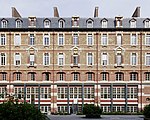Collège Sainte-Barbe
1460 establishments in Europe1460s establishments in FranceBuildings and structures in the 5th arrondissement of ParisFormer buildings and structures in ParisFrench school stubs ... and 2 more
Latin Quarter, ParisSchools in France

The Collège Sainte-Barbe is a former college in the 5th arrondissement of Paris, France. The Collège Sainte-Barbe was founded in 1460 on Montagne Sainte-Geneviève (Latin Quarter, Paris) by Pierre Antoine Victor de Lanneau, teacher of religious studies, as a college of the University of Paris. It was until June 1999 the "oldest" college of Paris. The Barbiste Spirit is kept alive through the Friendly Association of Old Barbistes, founded in 1820, recognized a public society since 1880, which is the oldest association of alumni of France, "l'Association Amicale des Anciens Barbistes".
Excerpt from the Wikipedia article Collège Sainte-Barbe (License: CC BY-SA 3.0, Authors, Images).Collège Sainte-Barbe
Rue Laplace, Paris 5th Arrondissement (Paris)
Geographical coordinates (GPS) Address Nearby Places Show on map
Geographical coordinates (GPS)
| Latitude | Longitude |
|---|---|
| N 48.8475 ° | E 2.3466666666667 ° |
Address
Bibliothèque Sainte-Barbe
Rue Laplace
75005 Paris, 5th Arrondissement (Paris)
Ile-de-France, France
Open on Google Maps










